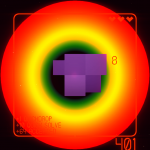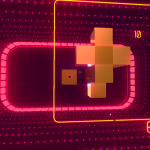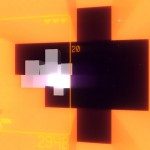When I was initially surveying the 17 Morpheus VR titles that Sony was showing at E3 2015, I came across one with a logo that was printed so small on the booth’s placard that I could hardly read it. I was about to pass it by when I saw a familiar symbol—a multicolored ‘P’—appear on the monitor below the placard. My heart skipped a beat as my brain recalled its meaning.
It was a logo representing Polytron, the indie developer behind one of my most beloved games, Fez (2012), a title that spoke deeply to me with its incredible art and music direction. Fez is on that short list of indie blockbusters that went well beyond its niche; going on to sell more than a million copies (as of late 2013), and be released on Xbox 360, PC, Linux, Mac, PS3, PS4, and PS Vita.
At this point there was no leaving the booth until I could get close enough to read the logo on the placard. I pushed my way through the crowd for a better look and was finally able to make out SuperHyperCube.
The game, it turns out, is being developed by Kokoromi, a somewhat nebulous group of game designers championing art and experimentation in game development. Fez creator Phil Fish was one of the group’s original members, and spun the game and Polytron out of it.
See Also: Here’s Every Morpheus Game Sony is Demoing at E3 2015
It’s easy to draw a quick comparison between SuperHyperCube and Tetris, as the game involves rotating shapes into correct positions. While playing, you are traveling down some rather psychedelic tunnels with a shape in front of you and an opening approaching at the end of the tunnel. Using the Morpheus VR headset for PS4, you can peer around the shape to see the opening at the end, and it’s up to you to rotate your shape to fit. As you progress, the shape you’re given becomes more complex, requiring more demand from your spatial senses to get it into a fitting orientation.
The task is a curious one, given that you’re asked to analyze and match a 3D object’s 2D representation to a known 2D outline. But the game is clearly built to enchant with its visual and sonic design as much as its game design, evoking a sort of retro-futuristic vibe with elements of neon signage and ’80s era computer visuals, all set in some spacey interdimensional medium. This emphasis on art direction is also shared with the other games that Polytron has been involved with, the aforementioned Fez and Panoramical.

SuperHyperCube’s development has spanned many years since being first deployed as an experimental game built for anaglyph 3D (the old red and blue glasses) and used a Wiimote for some hacked together headtracking (in the reverse style of Johnny Chung Lee’s) sometime around 2008.
You can see early footage from that initial prototype as shown at the Gamma art/game show in Montréal that year. One of the game’s developers, Renaud Bédard, wrote about the development of the prototype and credits Phil Fish, along with other Polytron and Kokoromi developers. Bédard would later go on to work closely with Fish on Fez.
In a late-2011 interview with Gamasutra, Phil Fish confirmed that he and the Kokoromi team were revitalizing the SuperHyperCube project to take advantage of the Xbox Kinect.

“[SuperHyperCube] was a proven concept that worked that we wanted to push further and we never did. That was like four years ago,” Fish said. “Then when Kinect came along we saw it would be a perfect fit, so we got that working. It was a finalist at IndieCade a couple weeks ago, and Microsoft seemed interested, and we might actually do something. So I already have something else [now that Fez is complete] that’s starting to get interesting.”
But the game never surfaced with the Kinect and the project went back into hibernation… until E3 2015 last week, now developed as a polished and exclusive launch title for Sony’s Project Morpheus VR headset with Kokoromi as the developer and Polytron as the publisher. It seems like the game and hardware may have been destined from the beginning, as Bédard said headtracking was the game’s best feature (which of course modern VR headsets excel at much more so than the Kinect).
Prior to the E3 reveal however, Phil Fish infamously cancelled Fez II and announced his exit from the game industry, even saying at one point that both Polytron and the Fez IP were up for sale—”No reasonable offer will be turned down.” But it’s unclear if Fish really sold the properties or departed Kokoromi. We’ve reached out to the relevant parties for comment but have yet to hear back.
Bédard, the aforementioned developer who worked on the SuperHyperCube prototype and with Fish on Fez, tells me that to his knowledge, “[Fish is] still involved with Polytron, and SUPERHYPERCUBE,” but having left the company a little while ago, maintains that he’s “far enough removed from Polytron at this point that I’m not a reliable source for insider info.”
We would love to see Fish make a triumphant return to games with SuperHyperCube, but whether or not he’s actively contributing to the project, it’s clear that he’s left his mark (note the similarities between the game’s logo and that of Fez, not to mention his design sensibilities represented throughout) and that Kokoromi’s work is as beautiful and imaginative as it was when Fish was part of the game’s development.















